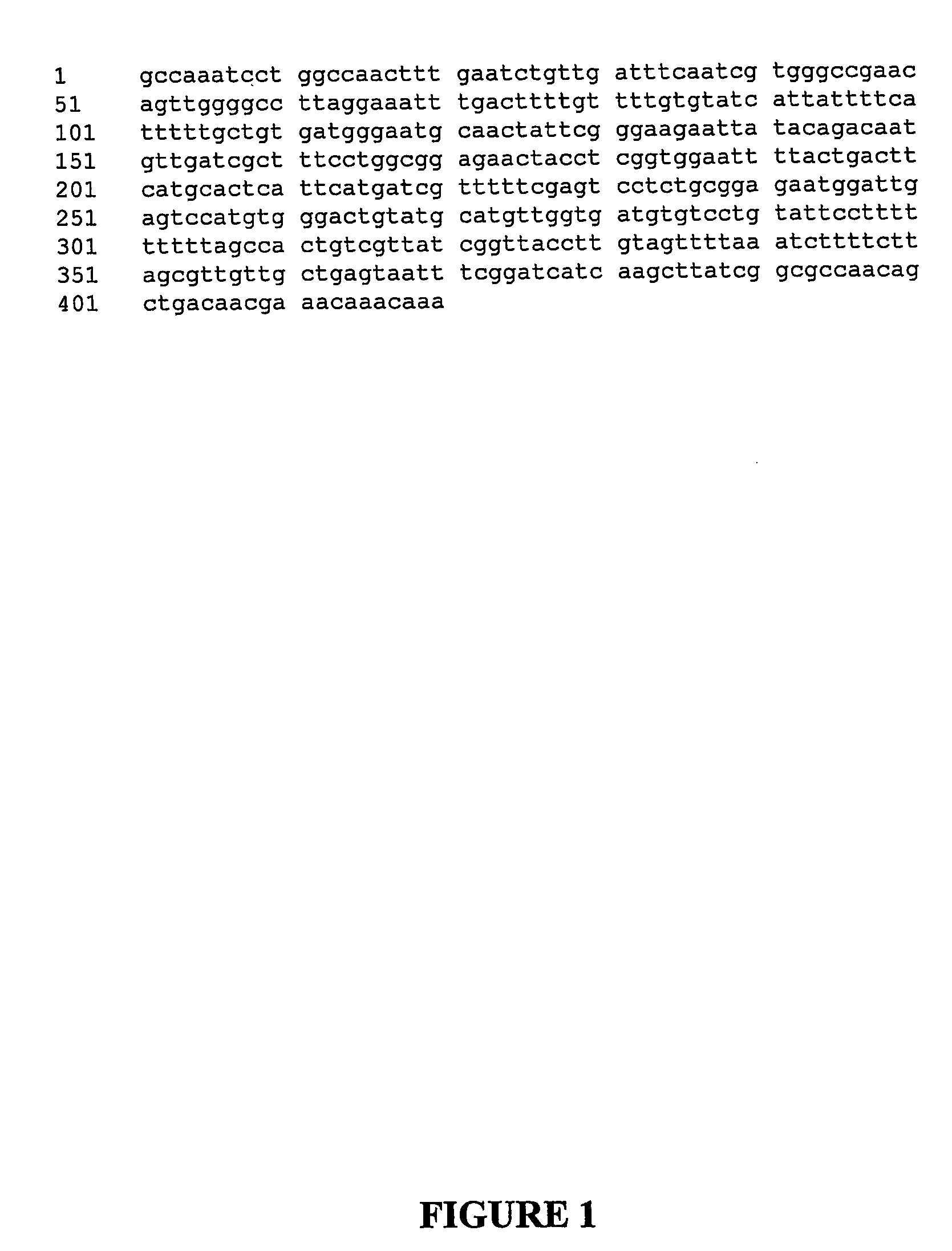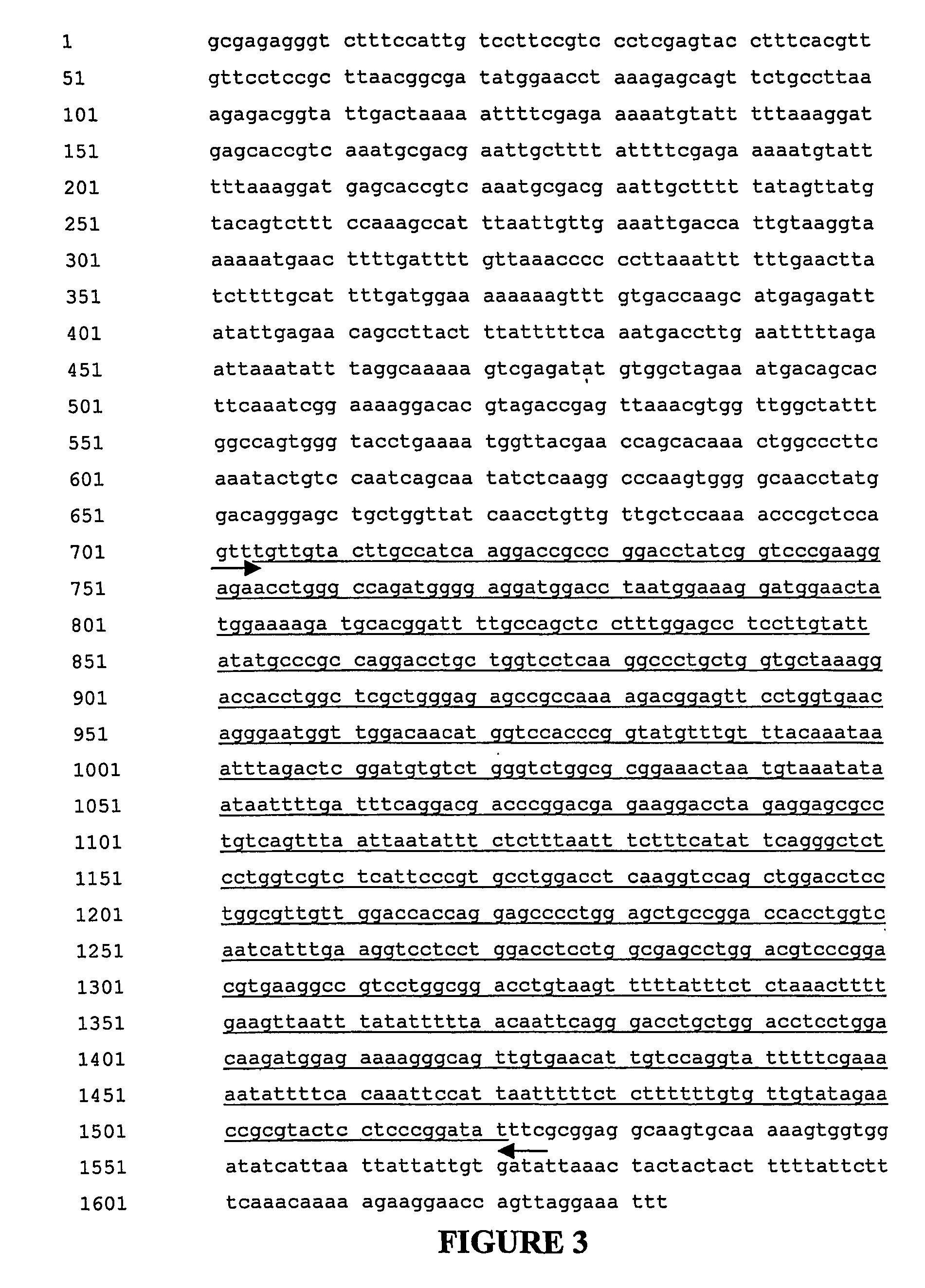Plants resistant to cytoplasm-feeding parasites
- Summary
- Abstract
- Description
- Claims
- Application Information
AI Technical Summary
Benefits of technology
Problems solved by technology
Method used
Image
Examples
example 1
Selecting B. tabaci Genes to be Silenced by siRNA Production in Plants
eIF5A Gene
[0238] As used herein, the terms “gene encoding eukaryotic translation initiation factor 5A (eIF5A) or “eIF5A gene” refer to the B. tabaci eIF5A gene cloned as described in the present invention herein below, comprising SEQ ID NO:2. These terms encompass the full-length sequence of the gene and fragments thereof and include DNA, cDNA, and RNA (e.g., mRNA) sequences.
[0239] The gene is an essential gene for completion of the life cycle of most Eukaryotes, including, for example, Drosophila. This gene was chosen for plant-mediated gene silencing in plant insects feeding on the cytoplasm during their normal life cycle, specifically the tobacco whitefly Bemisia tabaci. The B. tabaci gene was isolated and cloned for the first time by the present invention. The strategy for cloning the gene from B. tabaci was to use a conserved region of the gene as is known for other species and isolate the full cDNA by RA...
example 2
RNA Preparation, cDNA Synthesis and Generating the hpRNA Construct for B. Tabaci Genes
eIF5A Gene
[0248] A 314 bp fragment of the isolated eIF5A gene (SEQ ID NO:2) was taken for construction of the RNAi silencing element in a binary vector, using the same techniques and vectors as for DNA construct designed to silence the col-5 gene as described below.
vgsc Gene
[0249] Total RNA from B. Tabaci was isolated as described herein above. 5 μg of total RNA was used for cDNA synthesis using the Reverse Transcription System kit (Promega). The cDNA was amplified by PCR using primers P3-P6 described above. The sequence of the PCR product was determined and was found to be encoding for the expected sodium channel. The DNA construct for gene silencing according to the present invention is composed of a fragment of the target parasite gene in a sense and antisense orientation, separated by a nucleotide sequence derived from an intron of cca-1 gene, wherein the intron is forming a loop. The Pri...
example 3
Selecting a M. javanica Gene to be Silenced by siRNA Production in Plants
[0250] Silencing of nematode genes required for early developmental stage should result in lethality and stop the propagation of the nematode within the roots. Thus, a search was conducted for genes that were identified in M. javanica, were shown to cause early stage lethality and were also demonstrated to be silenced in RNAi assay in C. elegans (http: / / www.wormbase.org / db / serches / blast; Gonczy, P. et al., 2000; Frazer, G. A. et al., 2000). Two genes were identified and chosen for further analysis. Calponin, which is a troponin-like molecule linked to actin / tropomyosin filaments (Takahashi, K. et al., 1991; Castagnone-Sereno P. et al, 2001), and a special collagen gene, col-5 (Liu, J. et al., 2001). Two additional genes, hsp90 and the elongation factor 1 alpha (ef1-α), were excluded as they also exist in plants and their silencing might have deleterious effects on the host. col-5 gene was selec...
PUM
| Property | Measurement | Unit |
|---|---|---|
| Fraction | aaaaa | aaaaa |
| Fraction | aaaaa | aaaaa |
| Electrical conductance | aaaaa | aaaaa |
Abstract
Description
Claims
Application Information
 Login to View More
Login to View More - R&D
- Intellectual Property
- Life Sciences
- Materials
- Tech Scout
- Unparalleled Data Quality
- Higher Quality Content
- 60% Fewer Hallucinations
Browse by: Latest US Patents, China's latest patents, Technical Efficacy Thesaurus, Application Domain, Technology Topic, Popular Technical Reports.
© 2025 PatSnap. All rights reserved.Legal|Privacy policy|Modern Slavery Act Transparency Statement|Sitemap|About US| Contact US: help@patsnap.com



